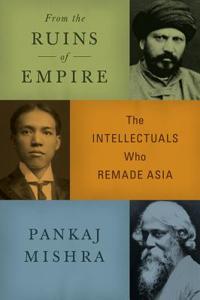
Want to learn the ideas in From the Ruins of Empire better than ever? Read the world’s #1 book summary of From the Ruins of Empire by Pankaj Mishra here.
Read a brief 1-Page Summary or watch video summaries curated by our expert team. Note: this book guide is not affiliated with or endorsed by the publisher or author, and we always encourage you to purchase and read the full book.
Video Summaries of From the Ruins of Empire
We’ve scoured the Internet for the very best videos on From the Ruins of Empire, from high-quality videos summaries to interviews or commentary by Pankaj Mishra.
1-Page Summary of From the Ruins of Empire
Overview
While the last 200 years have been seen as a period of economic and political progress in Western nations, rarely is this progress linked to Western imperialism. This key point explores how the East responded to modernism by looking at recent history and wars that shaped Eastern nation-states.
This is important because it’s told from the perspective of people who were colonized, rather than those who colonized them. It gives a close look at several key figures and their roles in making sure that Eastern traditions weren’t completely subsumed by Western influence.
In the following points, you will learn about how a naval battle changed history; how an intellectual in Persia helped form pan-Islamism philosophy; and how pork fat sparked a mutiny.
Big Idea #1: Trade interests drove a Western wedge into Asian countries, followed by political dominance.
Asians were subordinate to Western powers in the 1800s. This was because Napoleon led an army of 40,000 into Egypt and ostensibly claimed that he wanted protection for French trade interests.
After that, European countries also started to become more involved with China and India. For example, they became interested in the opium trade between those two nations.
Western powers were concerned about the imbalance of trade between China and Western countries. The British introduced opium to China, which was addictive, in order to combat that problem.
As more Chinese became addicted to opium, the Western traders raised their prices and made a killing. Slowly, the influx of money reversed, and European powers came to dominate the Chinese economy. The Chinese knew this was not sustainable, so they tried twice to rid themselves of opium addiction with wars against Western nations.
China essentially lost its fight with the British, which led to more favorable trade agreements for the West. Around that same time, India was under control of Great Britain after a rebellion in 1857.
The mutiny was an attempt to curb British dominance, and the mutineers had a numerical advantage over the British troops. However, they were not as well-trained or armed, which resulted in their defeat.
This ended Muslim native rule in India, leading to British control over the country. The Western power redesigned the political and economic environments of India and increased its presence on Indian soil. Britain divided up the country into separate regions that required more soldiers to govern them.
Big Idea #2: As Japan defeated Russia, Eastern powers took heart that Western dominance could be curbed.
The defeat of the Russians by Japan in 1905 signaled a shift in Western dominance in Asia. In 1868, Emperor Meiji came to power and ruled until 1912. He combined Eastern values with Western ideas about progress, focused on industrializing the country and consolidated control over it.
Japan was forced to open its borders in 1852 after the arrival of American warships. The Japanese were shocked at how powerful and advanced the United States’ navy was compared with their own, and this led them to change their economic, political, and social policies.
Significantly, a stronger Japanese military in 1905 led to its victory over Russian forces. This conflict started in 1904 when Japan and Russia fought for control of Korea and Manchuria (northeastern China). The small Japanese fleet won the battle, which greatly increased their territory and influence in the region.
In response, other Eastern leaders were inspired by Japan’s actions and worked to establish themselves amid the West’s waning power. The founder of Turkey, Mustafa Kemal Ataturk, looked at how Japan combined its traditional values with Western technological advancements as a way to resist Western powers.





